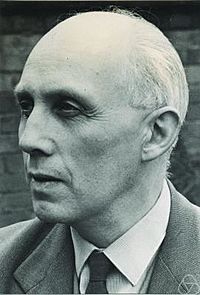Richard Rado facts for kids
Quick facts for kids
Richard Rado
|
|
|---|---|

Richard Rado, ca. 1967
|
|
| Born | 28 April 1906 Berlin, Germany
|
| Died | 23 December 1989 (aged 83) Reading, England
|
| Nationality | British |
| Alma mater | University of Cambridge University of Berlin |
| Known for | Erdős–Rado theorem Erdős–Ko–Rado theorem Milner–Rado paradox |
| Awards | Senior Berwick Prize (1972), Fellow of the Royal Society |
| Scientific career | |
| Fields | Mathematics |
| Doctoral advisor | G. H. Hardy Issai Schur |
| Doctoral students | Gabriel Dirac Eric Milner |
Richard Rado (born April 28, 1906 – died December 23, 1989) was a brilliant British mathematician. He was born in Germany and later moved to the United Kingdom to escape danger from the Nazis. He was very good at a type of math called combinatorics and graph theory. These areas of math deal with counting, arranging, and connecting things.
Richard Rado earned two PhDs, which are very high degrees in learning. He got one from the University of Berlin in 1933 and another from the University of Cambridge in 1935. He received a special scholarship that helped him study at Cambridge. After getting this help, Rado and his wife moved to the UK in 1933. Later, he became a Professor of Mathematics at the University of Reading in 1954. He stayed there until he retired in 1971.
Contents
Amazing Math Discoveries
Richard Rado made many important discoveries in mathematics. He worked a lot on combinatorics and graph theory. He even wrote 18 papers with another famous mathematician named Paul Erdős!
What is Combinatorics and Graph Theory?
Combinatorics is a part of math that helps us count and arrange things. For example, how many ways can you pick three friends from a group of five? Graph theory is about studying networks of points and lines. Think of a map with cities (points) and roads (lines) connecting them.
Important Discoveries
Richard Rado's work led to several important ideas in math.
The Rado Graph
There is a special kind of graph (a network of points and lines) named after Rado. It is called the Rado graph. This graph is very unique because it contains every other possible infinite graph inside it! Rado rediscovered this graph in 1964, but other mathematicians like Wilhelm Ackermann and Paul Erdős had worked on similar ideas before.
Theorems with Paul Erdős
Richard Rado worked with Paul Erdős on several key theorems:
- The Erdős–Rado theorem is an important idea in combinatorial set theory. It expands on another famous math idea called Ramsey's theorem, but for infinite groups of things. They published this theorem together in 1956.
- The Erdős–Ko–Rado theorem helps us understand how many sets of items can overlap in a certain way. Imagine you have many groups of friends, all the same size. This theorem tells us how many such groups can exist if every group must share at least one friend with every other group. Rado published this with Erdős and Chao Ko in 1961.
Other Key Ideas
- Rado's theorem is another result related to Ramsey theory. It helps solve problems about systems of straight-line equations. Rado proved this in his own special paper (thesis).
- The Milner–Rado paradox is a fascinating idea in set theory. It shows that you can divide a very long sequence of numbers (called an ordinal) into smaller parts, even if those parts seem too small to hold everything. Rado published this with E. C. Milner in 1965.
- In a field called matroid theory, Rado proved a basic idea about how to match items between different groups. This idea is like a more complex version of the Marriage Theorem, which helps find perfect pairings.
- The Klarner–Rado Sequence is a special sequence of numbers named after Rado and David A. Klarner.
Awards and Recognition
In 1972, Richard Rado was given a special award called the Senior Berwick Prize for his amazing work in mathematics.

